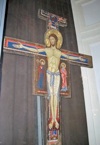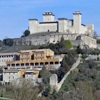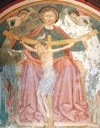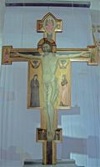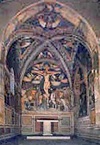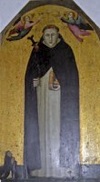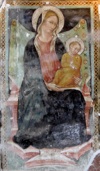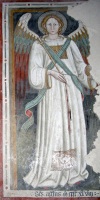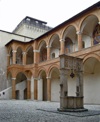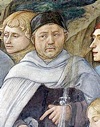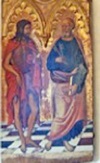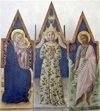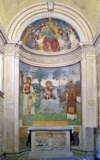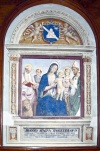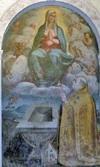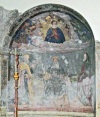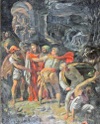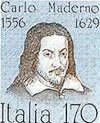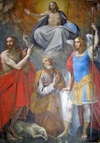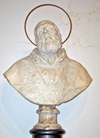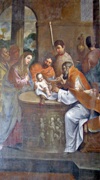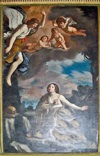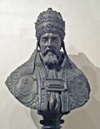

Early Artists
A unusual number of named artists who were active in the 12th and 13th centuries are known to have come from Spoleto. These include:
-
✴Alberto Sotio, whose painted Crucifix (1187) is illustrated here;
-
✴Rainaldo di Ranuccio;
-
✴Simone and Machilone (died after 1257)
-
✴[more]
Matteo di Giovannello, il Gattapone (died after 1374)
Cardinal Albornoz commissioned the Rocca di Spoleto (illustrated here) in ca. 1359. In 1362, he nominated il Gattapone as “offitialeni et suprastantem fabbrice rocche”. The last recorded payment to il Gattapone in this context was made in 1370. The construction of the huge arches that supported the Palazzo della Signoria (14th century is sometimes attributed to il Gattapone.
Maestro della Dormitio di Terni (ca. 1400)
Two works in Spoleto are attributed to the Maestro della Dormitio di Terni:
-
✴a detached fresco (ca. 1388) of the Madonna and Child enthroned in San Gregorio Maggiore, Spoleto; and
-
✴a fresco (1404) of the Madonna and Child with saints in the lunette of the outer portal of San Nicolò.
A fresco (ca. 1400) of the Trinity (illustrated here) in the crypt of San Ponziano is variously attributed to this master or to his follower, the Maestro del Trittico di Terni.
Maestro di Cesi (early 14th century)
Two works (early 14th century) from Santa Maria della Stella are attributed to the Maestro di Cesi:
-
✴the triptych of the Assumption of the Virgin and eight scenes depicting the events leading up to her death (now dispersed); and
-
✴a Crucifixion (Christus Triumphans), illustrated here, which if now in the Museo del Ducato di Spoleto.
Maestri di Santa Chiara di Montefalco (14th century)
This panel (ca. 1315) of the Madonna and Child with prophets from the church of Santa Maria, Vallo di Nera is attributed to one of two artists that are named for the frescoes (1333) in what is now the Cappella di Santa Croce in the nunnery of Santa Chiara da Montefalco. It is now in the Museo Diocesano.
Maestro di Fossa (14th century)
A number of works in Spoleto are attributed to this master, including this panel (14th century) of St Peter Martyr, which is in San Domenico.
Bartolomeo da Miranda (died after 1449)
The many works in Spoleto that by or attributed to Bartolomeo da Miranda are described in the page on the artist: they include this fresco (1437) in the crypt of San Ponziano.
Maestro di Eggi (died after 1451)
The church of San Michele, Eggi (outside Spoleto) contains the autograph works of the Maestro di Eggi, which include this frescoes (1448) of St Michael. There are also frescoes attributed to him in:
-
✴the churches of San Gregorio Maggiore, San Giuliano (dated 1442) and SS Giovanni e Paolo (dated 1445);
-
✴an aedecule in the wall of a house in Via Ponzianino;
-
✴the Abbazia di San Pietro in Valle, Ferentillo; and
-
✴the church of San Brizio, outside Spoleto.
Bernardo Rossellino (1409-64)
From Settignano, near Florence
Filippo Lippi (1406-69)
Filippo Lippi and his associates executed frescoes (1467-9) of scenes from the Life of the Virgin in the apse of the Duomo. This detail, which includes a self-portrait, is from the central scene of the Dormition of the Virgin.
Nicola di Ulisse (died after 1472)
From Siena
Neri di Bicci (1418-91)
Neri di Bicci trained in the Flroentine workshop of his father, Bicci di Lorenzo, and took it over when his father died. This altarpiece (ca. 1464) of the Madonna della Neve, which came from the pieve of Abeto, near Norcia and which is now in the Museo Diocesano, Spoleto, is attributed to him.
Francesco da Pietrasanta (died 1494)
Francesco da Pietrasanta received payments for the design and construction of Santa Maria del Massaccio (later San Rocco) in 1490-2.
Jacopo di Vinciolo (died after 1495)
Jacopo di Vinciolo is well-documented in Spoleto in the period 1444-95. He had particularly strong links with the Franciscans of SS Simone e Giuda there. This panel (1466) of SS John the Baptist and Peter probably belonged to the polyptych that the friars commissioned from Jacopo di Vinciolo in 1466 for the high altar of the church. It is now in the Museo del Ducato di Spoleto.
Bernardino di Nanni dell’ Eugenia (died after 1495)
Probably from Gubbio
Two frescoes in San Michele Arcangelo di Gavelli are attributed to this artist.
[Temporary link to Bernardino di Nanni]
Nicolò di Liberatore, l' Alunno (1430-1502)
Nicolò di Liberatore was perhaps the most important participant in the vibrant artistic milieu of Foligno in the 15th century. These panels from Santa Maria delle Grazie, which are now in the Museo del Ducato di Spoleto, are attributed to him. Scholars recognise a probable contribution by Ugolino di Gisberto, who was documented as an apprentice in his workshop in 1458.
Bernardino di Betto, Pintoricchio (ca. 1454–1513)
Bishop Costantino Eroli, who built the Cappella di San Leonardo in the Duomo, presumably commissioned its decoration. The attribution of its frescoes (ca. 1497) to Pintoricchio was first made in 1848, but it is now generally accepted.
Giovanni di Pietro, lo Spagna (died 1528)
Lo Spagna’s most prestigious assignment here was in the Rocca di Albornoz, for which he painted this fresco (1514-5), including the fictive altarpiece illustrated here. He also painted important frescoes that survive in churches outside Spoleto:
-
✴San Giacomo di Spoleto; and
-
✴San Michele Arcangelo, Gavelli.
Bernardino Mezzastris (died after 1539)
This damaged fresco high up in the apse of San Salvatore, which depicts the Crucifixion with saints, is attributed to Bernardino, the son of the more famous Pierantonio Mezzastris.
Jacopo Siculo (1490-1544)
The frescoes and altarpiece (illustrated here) that Bishop Francesco Eroli commissioned for the walls of his family chapel in the Duomo in ca. 1535 are attributed to Jacopo Siculo.
A documented fresco (1537) of his in Santa Maria di Loreto has recently been recovered from under plaster and restored.
Tommaso Bernabei, il Papacello (died 1559)
From Cortona
Dono Doni (1505-75)
This damaged fresco (1530) in San Giacomo di Spoleto was part of an extensive commission for frescoes in the church from Giovanni di Pietro, lo Spagna (above). It was completed by his young assistants, Dono Doni and Cecco di Bernardino d’ Assisi after his death. It depicts the Virgin in glory with SS Peter, Antony Abbot and Bartholomew.
Arrigo Fiammingo (1519-97)
From what is now Belgium
Arrigo Fiammingo da Malines (Hendrik van den Broeck, Heinrich Paludanus) was one of very few Flemish artists who established careers in Italy in the 16th century. An altarpiece (ca. 1570) of the Madonna del Rosario in San Giacomo was documented in 1625 as the work of “Henrico Fiamengo”, who was almost certainly Arrigo Fiammingo.
[Temporary link to Flemish Artists]
Cesare Nebbia (died 1614)
Cesare Nebbia played an active part in the redecoration of the Duomo in his native city from 1566. He also established a reputation in Rome, particularly under Pope Sixtus V (1585-90). In Spoleto, this panel (1574) of the Capture of Christ in Cappella Benedetti, San Domenico, is attributed to him.
Carlo Maderno (1556-1629)
Carlo Maderno, who moved to Rome to work with his uncle, Domenico Fontana, became one of the leading architects of the Baroque period. His work in Umbria included the design of the Barberini Monument (ca. 1623) on the Fonte di Piazza, Spoleto.
Benedetto Bandiera (1557-1634)
From Perugia
The earliest known works of Benedetto Bandiera were in Spoleto:
-
✴the frescoes (1587) in Palazzo Bartoletti, one of which depicts Susanna and the elders and is signed; and
-
✴fifteen documented panels (1597) in the vaults of the Cappella di Santa Caterina in the right transept of the Duomo, which no longer survive.
[Temporary link to Benedetto Bandiera]
Giuseppe Cesari, il Cavalier d’ Arpino (1568-1640)
The Cavalier d’ Arpino was probably the most important artist in Rome during first two decades of the 17th century, when he enjoyed the esteem and patronage of Pope Clement VIII. His altarpiece (ca. 1600) depicting Christ the Redeemer with saints in the Museo Diocesano is from the church of San Nicolò in Agriano, Norcia. It depicts Christ in glory with SS John the Baptist, Joseph and Michael Archangel.
Giovanni Baglione (1573-1644)
From Rome
Giovanni Baglione was an important painter in Rome and an art historian. He is best remembered for his biographies of his contemporary artists. The Campello family commissioned three panels (1609) from him for their new chapel in Santa Maria di Loreto. These panels, which are now in the deposit of the Commune, depict: the Visitation; the Nativity (signed and dated); and the Adoration of the Magi.
[Temporary link to Giovanni Baglione]
Alessandro Algardi (1598-1654)
Alessandro Algardi succeeded Gianlorenzo Bernini as papal court sculptor in 1644, with the accession of Pope Innocent X. This bust (ca. 1640) from San Filippo Neri, which is now in the Museo Diocesano, is attributed to him.
Bernardino Gagliardi (died 1660)
Bernardino Gagliardi signed this altarpiece (17th century) of the Circumcision of Jesus in the Museo Diocesano, which came from the Madonna delle Lacrime, Trevi.
Giovanni Francesco Barbieri, il Guercino (1591-1666)
This panel (17th century) depicting St Mary Magdalene from the nunnery of Santa Maria Maddalena is attributed to the workshop of this prolific Baroque artist. It is now in the Sala dei Duchi of Palazzo Comunale.
Gianlorenzo Bernini (1598-1680)
Gianlorenzo Bernini was the most important sculptor in Rome for much of the 17th century. Pope Urban VIII commissioned this bust (1640-4) from him for the Duomo of Spoleto, in memory of his period as Archbishop of the city. It is now in the Museo Diocesano.
Francesco Refini (died after 1692)
From Spoleto
A number of works attributed to this artist, including one or two that are signed and/or dated by inscription, survive in Spoleto.
[Temporary link to Francesco Refini]
Sebastiano Cipriani (died ca. 1740)
Cipriani’s most prestigious commission in Umbria was the design (1717) of Palazzo Collicola in Spoleto.
Sebastiano Conca (1680–1764)
Sebastiano Conca, who was one of the leading artists in Rome in the early 18th century, painted a number of works for clients in Spoleto. These include three panels (ca. 1735) for Santa Maria della Manna d' Oro, one of which (the Birth of the Virgin, illustrated here) is now in the Museo Diocesano.
Gaetano Lapis (1704-76)
From Cagli, based mostly in Rome
Gaetano Lapis trained under Sebastiano Conca in Rome the 1720s and subsequently established a successful career there. In Spoleto, two altarpieces (18th century) in San Filippo Neri are by or attributed to him:
-
✴the presentation of the Virgin; and
-
✴the Crucifixion.
[Temporary link to Gaetano Lapis]
Etienne Parrocel, il Romano (1696-1776)
From Avignon; based in Rome
Etienne Parrocel signed an altarpiece (1758) of the Incredulity of St Thomas in SS Stefano e Tommaso (later Santa Maria della Stella). [It was in the Pinacoteca - is it in Palazzo Comunale?]
[Temporary link to Etienne Parrocel]
Francesco Appiani (1704-93)
From Ancona; trained in Rome; based in Perugia from 1743
The altarpiece (18th century) by Francesco Appiani on the high altar of San Ponziano depicts the decapitation of St Pontian at Ponte Sanguinario.
[Temporary link to Francesco Appiani]
Liborio Coccetti (ca. 1739-1816)
From Foligno
Liborio Coccetti, who became one of the favoured artists of Pope Pius VII, left very little in his native Foligno. His works in Spoleto include frescoes (ca. 1780) in Palazzo Benedetti di Montevecchio and two altarpieces (1784) in the Cappella del Sacramento of the Duomo.
[Temporary link to Liborio Coccetti]
Domenico Bruschi (1840-1910)
From Perugia
Domenico Bruschi was one of the most important artists of the Risorgimento. His work in Teatro Caio Melisso in ca. 1880 included:
-
✴the apotheosis of Caius Melissus, on the fire curtain; and
-
✴the fresco of Apollo and the muses, on the ceiling.
[Temporary link to Domenico Bruschi]
Return to the home page on Spoleto.
